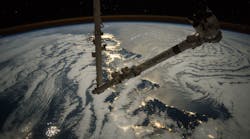Spurred by NASA subcontracts and industrial funding, students at Embry-Riddle Aeronautical University are helping to design autonomous spacecraft capable of reaching to Mars and beyond in this solar system. Working in the school’s Engineering Physics Propulsion Lab (EPPL), students are developing self-piloted spacecraft as well as steam-powered propulsion systems that could aid research on the Moon and Mars, and possibly even beyond the solar system. Another student team is working on a robotic arm for the spacecraft that could collect samples from the surface of a planet or asteroid. By collecting samples from other planets, research could reveal whether those planets were capable of supporting life from Earth.
These projects at the EPPL are funded by industrial sponsor Jay D’Amico, CEO and owner of several industrial companies in Louisiana and Texas, and through grants from the College of Arts & Sciences (COAS) and the College of Engineering at the Daytona Beach Campus; NASA is supporting the steam-powered propulsion research. Plans are also underway between the College of Arts & Sciences, the University of Luxembourg (an international research university in Europe), and Embry-Riddle’s Worldwide Campus to establish a similar joint Space Research Laboratory in Luxembourg.
“The interdisciplinary study taking place in the lab has students from different colleges working together,” said Dr. Karen Gaines, professor and dean of Embry-Riddle’s College of Arts and Sciences, where the lab is part of the engineering physics degree program in the Department of Physical Sciences. “It really shows the breadth of their interests and ability. Most importantly, the students are learning from each other and their mentors.”
Approximately 25 undergraduate students work in the EPPL, which opened in 2016, under the direction of Dr. Sergey V. Drakunov, professor of engineering physics. In addition to support from Drakunov, the students receive guidance from mechanical engineering professor Dr. Patrick Currier, as well as from Michael DuPuis, an Embry-Riddle alumnus and doctoral student who is a principal investigator of Robotics and Autonomous Systems for NASA. “I’m impressed with the students’ work and their technical advancement and knowledge while working in the lab,” said DuPuis, who is also conducting work in the laboratory for his aerospace engineering doctorate at Embry-Riddle. “Everything here is student-designed and built.”

